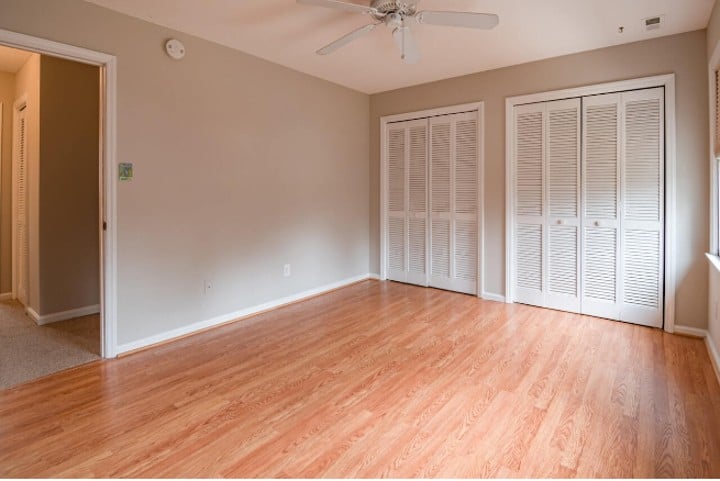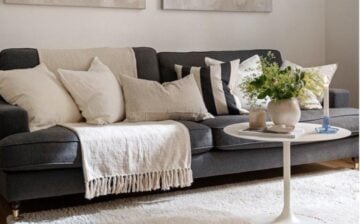
Interior doors play a vital role in any home. Beyond separating rooms and providing privacy, they effortlessly harmonize with your decor, improve aesthetics, and boost functionality in surprising ways. No wonder the global market size for these products is projected to reach $93.1 billion by 2030. Whether you’re building from scratch or doing much-needed home improvement, finding the right fit is crucial to personalizing your home’s look and feel.
But which style is right for your unique space? Join us as we explore how to choose the interior door that complements your space and adds personality to your home in this essential guide.
Read on.
Door Types to Consider When Selecting Interior Doors
Interior doors come in many styles, designs, and configurations. Depending on your space and preference, you can choose natural wood, fiberglass, steel—commonly used for entry doors—or a door with a glass insert.
You can also opt for single-panel or double-panels, depending on your opening size. Let’s compare some options.
Exploring Different Interior Door Styles
Here are some common styles with examples:
Modern: Characterized by clean lines, minimal design, and a sleek appearance, modern doors often feature glass elements and innovative materials. An example is a flush door with hidden hinges.
Rustic: Embracing a cozy, countryside charm, rustic styles showcase natural elements like wood with visible grain and knots. An example is a barn door made from reclaimed wood.
Classic: Exuding timeless elegance, classic styles draw inspiration from historical periods, featuring recessed panel designs and intricate details. An example is a four-panel door with refined detailing.
Contemporary: Blending modern elements with traditional features, contemporary styles have a versatile and up-to-date look, incorporating various materials and textures. An example of a contemporary door is the glass and wood combination design.
French: French doors add a touch of elegance and allow light to flow between rooms. They have glass panels or panes that slide open inward or outward, and their frames may be made of wood, metal, or uPVC.
Enhancing the Aesthetics of Interior Doors: Colors and Paint
Knowing how to choose interior doors that fit your design aesthetic is important. Fortunately, there are a wide variety of colors to choose from. Check out these options:
- Neutral Colors: Timeless and versatile, shades like white, beige, gray, or cream can seamlessly blend with your walls and decor.
- Bold Colors: Want to make a bold statement? Opt for vibrant shades like navy blue, deep red, emerald green, or mustard yellow to add personality to your space.
- Contrast Colors: Create a striking visual impact by using contrasting colors between the panels and walls, adding visual interest to the room. A black door against white walls is a good example of this style.
- Two-Tone: Experiment with two-tone designs, painting the interior and exterior sides in different colors—e.g.: pastel blue on one side and white on the other—to add a creative touch.
- Decorative Painting: Add personalized and eye-catching designs through decorative elements like murals, stencils, or hand-painted motifs on the panels.
By exploring these color options and painting techniques, you can create a cohesive and visually appealing space.
Choosing Interior Doors Considering Materials
Materials are another important factor to consider when shopping. Understanding the unique characteristics of materials like wood, solid core, hollow core, metal, glass, and fiberglass will help you find the best type of interior doors for your home.
Dore Core Types
Here are the common core types and their features:
| Solid Wood Core |
|
| Hollow Core |
|
| Solid Core |
|
Glass Types
If you prefer something with glass, you also have a variety of options to choose from. Some of the popular options are:
| Clear Glass |
|
| Frosted Glass |
|
| Tempered Glass |
|
| Plexiglass |
|
| Polycarbonate |
|
Interior Doors for Different Rooms
With a vast array of interior door choices, it’s important to consider your space and needs when choosing interior doors design.
Here are 7 types and their best-suited locations.
- Sliding doors slide horizontally along tracks and are a space-saving option. They are great as closet doors, for laundry rooms, and small bedrooms, as they do not require extra clearance for opening.
- Pocket doors slide into a concealed wall pocket, making them completely hidden when open. They are an excellent choice for areas with limited wall space, such as small bathrooms or powder rooms.
- Flush doors have a flat and smooth surface with no visible panels or designs. They work well for bedrooms and living rooms, blending seamlessly with the walls to create a sleek appearance.
- Barn doors are rustic and feature a sliding mechanism that runs along the wall, adding a charming and farmhouse-style touch to a space. They are perfect for spaces where a conventional swinging style may not fit, such as pantries or home offices.
- Panel doors have raised or recessed panels on one or both sides, creating depth and dimension. They are ideal for bedrooms, living rooms, and dining areas.
- French doors are commonly used to connect interior and outside spaces, such as patios or gardens. They are also ideal for living rooms or dining areas where you want to maximize natural light.
- Invisible or hidden doors are designed to blend seamlessly into the walls, becoming nearly invisible when closed. They can be used where a seamless and concealed look is desired, such as a home library.
Choosing Doors: Define Your Interior Needs
When selecting interior doors, your specific needs and requirements must be front and center. For most people, the requirements are:
- Soundproofing: For sound isolation, opt for solid-core or soundproof products that minimize noise transfer between rooms.
- Security: Choose strong and sturdy materials like solid wood or metal, along with reliable locking mechanisms for enhanced security.
- Transparency: Decide on clear glass for unobstructed views and natural light, or frosted glass for partial privacy.
- Space Efficiency: Sliding or pocket styles are ideal for saving space in small rooms, closets, or areas with limited clearance.
- Handing: Determine if the panel needs to be right-handed or left-handed, depending on the room’s layout and swing direction.
- Aesthetics: Consider the door’s style, design, and finish to complement the overall interior decor.
- Material: Choose materials based on durability and aesthetics, such as solid wood for a classic look or fiberglass for low maintenance.
Understanding Door Measurements and Rough Openings
Size matters a lot when it comes to knowing how to choose interior door style.
Standard interior doors are typically 80 inches tall and 32 inches wide. To measure the width, use a tape measure between the jamb’s inside edges at the top, middle, and bottom. For height, measure from the floor to the top of the jamb on the left, center, and right sides.
Rough openings, where panels fit in walls, should be 2 inches wider and 2 ½ inches higher to allow for adjustments and clearance. If you’re installing in a new construction or a wall without an existing opening, seek professional advice before getting started.
What Type Of Interior Doors Are Best
There you have it, a comprehensive guide on choosing the ideal interior door for your home. As you explore options on the market, remember to consider your specific needs and preferences, whether it’s privacy, aesthetics, or space-saving.
Sliding doors are ideal for limited space, panel or French doors add a classic touch, while wooden options are good for insulation and soundproofing.
When it comes to actually making the purchase, prioritize quality by buying from reputable suppliers like United Porte. Don’t compromise on the safety and aesthetics of your home by settling for subpar products. Choose wisely and enjoy durability for years to come.
We hope you found this blog post on How to Choose the Right Interior Door: Essential Guide, useful. Be sure to check out our post on How Good are Bi-Fold Doors? Facts and Benefits To Know for more great tips!
Have Experience in the Moving Industry? Want an Additional Income Stream? Work With All Around Moving!
The company’s Work With Us program, provides the moving consultants with the opportunity to run a Moving & Relocation Consultant business from anywhere there is a working internet. All Around moving is already licensed, and provide you with a dedicated phone line, moving software for leads management, email address, and a complete set up.
All Around Moving even provides the carriers, or you can use your own carriers. A nominal one-time start-up fee gives you the “key” for your business to be up and running at no time. There is monthly recurring expense, and the cost of the leads you want to work on. We share profits with you from all jobs you book with us. Click here to learn more.





